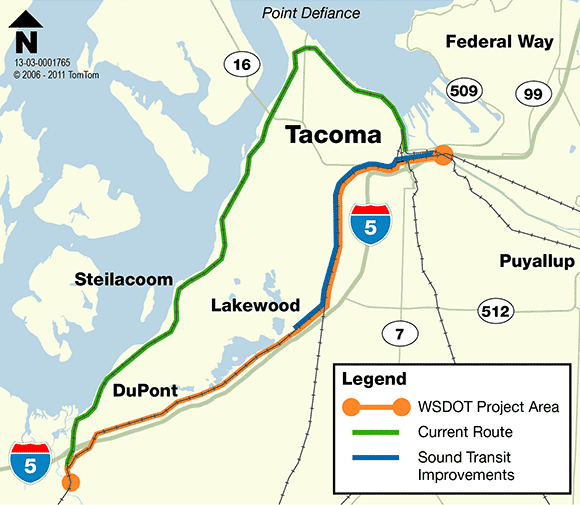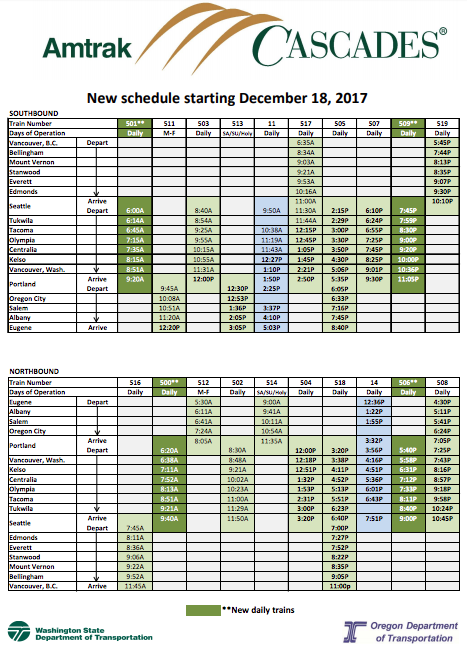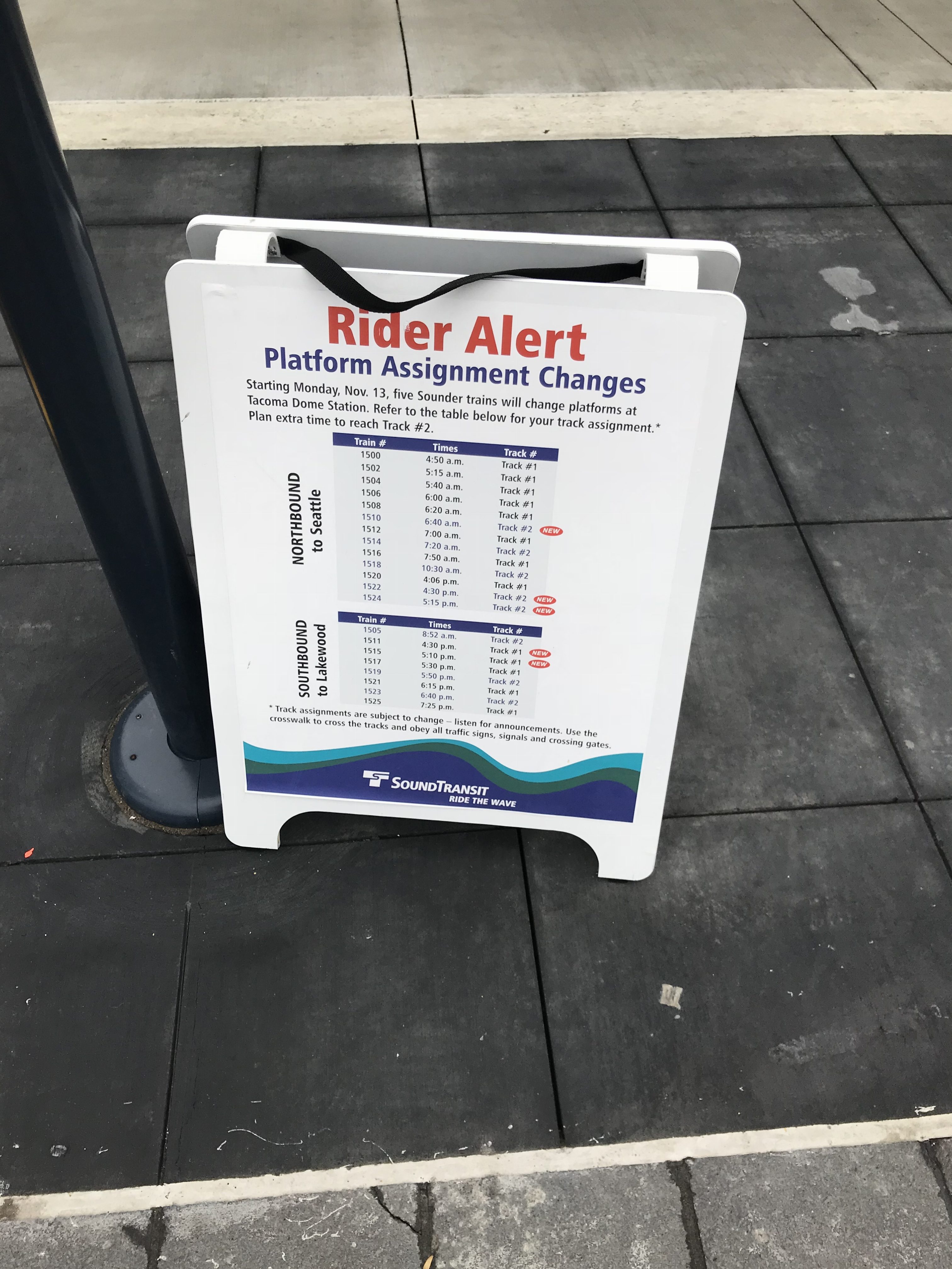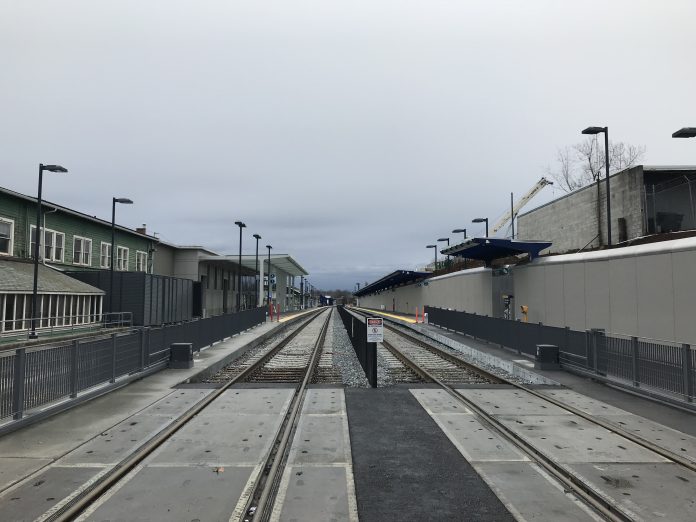Editor’s Note: After the inaugural train trip of faster Cascades service ended in derailment, we issued this statement.
Amtrak Cascades will begin new service today between Seattle and Portland. Two additional roundtrips will operate filling out the daily schedules. Many passengers will also notice several other major changes, such as reduced travel times, a new Tacoma station, and different scenery.
Faster and More Frequent Service

Trip times between Portland and Seattle will be shorter with the full opening of the Point Defiance Bypass via an inland route near I-5. The Washington State Department of Transportation (WSDOT) estimates that travel through the corridor could shave off about 10 minutes per trip and allow trains to top out at 79mph–the legal maximum under federal railroad law for Class 4 tracks. That will bring total travel time down to around 3 hours and 10 minutes between Seattle and Portland while also improving overall reliability.
The Point Defiance corridor has consistently been a chokepoint for passenger rail since the tunnel underneath Ruston is single-tracked. Freight rail traffic has regularly delayed passenger trains and the winding nature of the tracks has kept trains slow generally. Some riders, however, will mourn the loss of the waterside ambiance that the Point Defiance corridor provided.
Amtrak Cascades is now using new Charger locomotives to pull the Talgo tilting trainsets. These locomotives are designed by Siemens to be much more fuel efficient and environmentally-friendly than the EMD F59PHI locomotives operated by Amtrak Cascades. They also have more power and could hit top speeds of 125mph if the Federal Railroad Administration grants approval of higher speeds on certain sections of the Amtrak Cascades corridor in the future.
The new schedule will mean that passenger trains will depart every two to three hours giving riders more choice and making rail a more viable option. The first and last Portland-bound trains from Seattle will be 6am and 7:45pm. Likewise, first and last Seattle-bound trains from Portland will be at 6:20am and 7:25pm. The schedule also retains several through service options to Vancouver, British Columbia and Eugene, Oregon.

WSDOT eventually plans to increase passenger rail service between Seattle and Portland to 13 daily roundtrips by 2035 and further reducing travel times to as low as 2 hours and 30 minutes. Meanwhile, ongoing planning efforts could eventually bring conventional high-speed rail or maglev technology to the corridor, more drastically changing the intercity passenger rail landscape.
New Station in Tacoma
Using the Point Defiance Bypass means that both Amtrak Cascades and Coast Starlight trains will be routed off of Burlington Northern Santa Fe tracks near the Tacoma junction. Instead, trains will be routed onto the old Milwaukee Road tracks that Sounder trains have long-operated on to serve Tacoma Dome Station. Trains will cross a new double-track trestle east of Freighthouse Square that opened earlier this year.
The alternate route also means that Freighthouse Square will now serve as the main station in Tacoma instead of the low-slung, bunker-style 1980s station north of Puyallup Avenue. The building consists of a mix of curiosity shops and restaurants in a traditional warehouse style building that stretches nearly a quarter mile. WSDOT negotiated with the owner of Freighthouse Square to purchase space near the building’s west end for passenger check-in, waiting areas, baggage handling, and other amenities. For a short time during negotiations, there was fear that the owner of Freighthouse Square might not make an agreement in time since grants were on the line. That would have meant scrapping the station plan altogether.

The new station space is about 10,000 square feet, a modest size for a key terminal like Tacoma, but the facilities will provide a comfortable and modern experience for customers. The station will also help consolidate intercity train service with regional and local transit connections at Tacoma Dome Station, such as Tacoma Link and Sounder South Line as well as Pierce Transit and ST Express bus routes. Sound Transit has similar passenger facilities in the building just east of the Amtrak facilities.
With the introduction of Amtrak service at the Frieghthouse Square station, riders will need to be aware of new pick-up and drop-off protocols. All Amtrak trains passing will use Track 1 platform for arrivals and departures in order to better serve passengers with baggage. This means that local Sounder trains serving the station around the same time as an Amtrak train will be routed to Track 2 platform, but at all other times use Track 1 platform. Passengers should take caution by arriving early to the station and only accessing the Track 2 platform at designated locations.
In the year ahead, passengers in Tacoma still have more to look forward to with completion of aesthetic elements to the facade of the new trestle and extended platforms over E 26th St and E G St.
A full album set of the station is available on our Flickr account.
Stephen is a professional urban planner in Puget Sound with a passion for sustainable, livable, and diverse cities. He is especially interested in how policies, regulations, and programs can promote positive outcomes for communities. With stints in great cities like Bellingham and Cork, Stephen currently lives in Seattle. He primarily covers land use and transportation issues and has been with The Urbanist since 2014.


